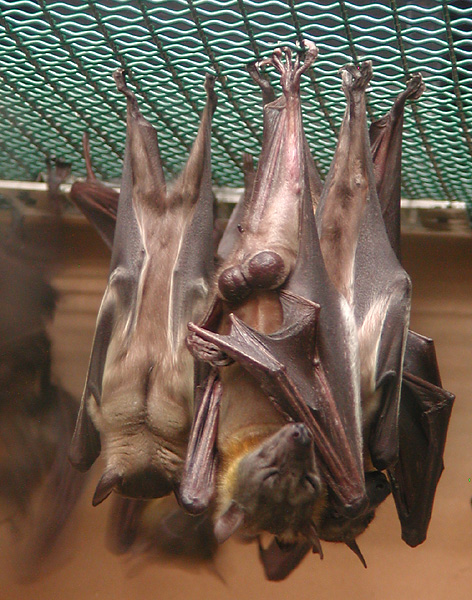10 Weird Types of Sleeping - During flight and even underwater
By: Stefan Anitei, Science Editor - Softpedia

Fruit bats sleeping
All vertebrates sleep, from fish to mammals. And even some invertebrates, like the insects. During sleep, the body enters in a predominantly anabolic phase, when it develops, grows, heals and builds muscle; the immune system is at its peak (that's why, when we’re ill, we wake up without the cold).
The lack of sleep impairs the functioning of the brain. Sleep is necessary to organize the memories we amass during the day and to give our bodies time to rest.
Here are some types of sleep, sleep behavior and sleep beliefs that can be odd, different or just false.
1. Birds can sleep while flying! During the migration, birds take hundreds of naps during the day, each lasting only 9 seconds on average, to compensate the night sleep loss. Many song birds travel mostly during the night to avoid birds of prey and often for long hours at a time, leaving little time for sleep.
The scientists discovered also two other forms of sleep besides the shut-eye type. The unilateral eye closure (UEC) means the birds rested one eye and one half of the brains while the other eye and brain hemisphere remained open and active, keeping them semi-alert to danger.
Other process, named drowsiness, are characterized by partially shutting both eyes, which still allows some visual processing.
By alternating between naps, UEC and drowsiness, migratory birds can reap some of the benefits of sleep while only marginally increasing their risks of being caught by prey birds.
2. Even if you won't see a fish with the eyes shut down, fish do sleep! Physiological measurements showed that fish pass through periods of drowsiness accompanied by low responses to environmental factors. It is a very primitive type of sleep, not related
to drowsiness in mammals.
3. There is one widespread belief: Snakes do not sleep! That's false: they do sleep, but the ‘no sleep’ myth comes from the fact that their eyelids are joined and transparent, so they sleep with their eyes open...
4. On the other hand, hares do not sleep with their eyes open. This false belief comes from the next behavior: during hunt, the hare won't start running at the slightest signal of danger. It will wait for its covering and camouflage to make it undetectable. If the hounds spot it, the hare starts running as if waken up from a deep sleep while its eyes are wide open.
5. After the primates, dolphins and whales have the largest brains. These brains need resting, just like ours do. But in their sea environment, whales and dolphins must be conscious breathers: They have to actively decide when to breathe. This requires the individual to be awake, which is quite a problem, since during sleep the brain is in an unconscious state.
Catnaps are not an option. The solution found by whales and dolphins is to let one half of the brain sleep at a time. This way, the animal is never completely asleep, but it gets the necessary rest. Electroencephalograms (EEGs) of dolphin brains showed that while sleeping, half of the dolphin's brain does indeed "shut down" while the other half is active. This state lasts about 8 hours a day.
Dolphins and whales must sleep near the surface of the ocean so they can come up for breathing easily. Dolphins are frequently seen "logging," swimming slowly at the surface, making very few movements.
6. Sea otters also sleep in the sea. To solve the problem, they sleep wrapped in algae so that they can float and not be carried away by the water currents while sleeping.
Seals sleep much in the same manner.
7. The currents and twirls of the Indus river are so strong that the dolphin species inhabiting this river must swim ceaselessly so as not to drawn. That's why they don’t sleep more than about... one minute. It is the shortest sleep time seen in a mammal.
8. The only animals known to sleep upside down are the bats, the sloths and ...the hanging parrots (Loriculus species), tiny birds living in Southeastern Asia, from Indonesia to New Guinea.
9. Bears, skunks and other carnivores do not really hibernate. They can wake up very quickly from their winter sleep if disturbed and their temperature, heart beat and pulse do not drop significantly.
10. Have you heard about sexsomnia? These are sleep-related disorders linked with abnormal sexual behaviors and experiences while sleeping.
For some people, this might sound funny, but it can actually be disturbing, annoying, embarrassing and a potentially serious problem for some individuals and couples.
These problems include parasomnias (sleepwalking and confusional arousals with or without obstructive sleep apnea) connected with abnormal sleep-related sexual behaviors (sexual vocalizations, masturbation, fondling the other person, sexual intercourse with or without orgasm, aggressive sexual behaviors), sleep-related sexual seizures (sexual vocalizations, libidinal hyperarousal, genital arousal, ictal orgasm, sexual automatisms, aggressive sexual behaviors), sleep conditions connected with abnormal sexual behaviors occurring during wakefulness and wake-sleep transitions (Kleine-Levin syndrome, a rare condition characterized by recurrent hypersomnia, connected with hypersexual and deviant sexual arousal and behaviors; severe chronic insomnia linked to high libido, genital arousal, compulsive sexual behaviors or restless legs syndrome combined with masturbation, rhythmic pelvic/coital-like movements)
Other special conditions of sexsomnia are narcolepsy (frequent and uncontrollable periods of deep sleep) displaying sexual hypnagogic (drowsiness)/hypnopompic (semiconscious state prior to complete wakefulness), cataplectic (muscle weakness) orgasm; sleep exacerbation of persistent sexual arousal syndrome without high sex drive or sexual behaviors; sleep-related painful erections and increased sexual activity (masturbation and intercourse); sleep-related dissociative disorders: pelvic movements and other sexualized comportments, reenactments of past sexual/physical abuses; night psychotic disorders like sexual delusions/hallucinations after awakenings and various sleep and sex connections like masturbation, sexual intercourse, sexual hypnagogic/hypnopompic hallucinations with sleep paralysis
Linkback:
https://tubagbohol.mikeligalig.com/index.php?topic=3561.0